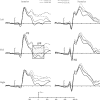Long-term exposure to high altitude attenuates verbal and spatial working memory: Evidence from an event-related potential study
- PMID: 30891949
- PMCID: PMC6456776
- DOI: 10.1002/brb3.1256
Long-term exposure to high altitude attenuates verbal and spatial working memory: Evidence from an event-related potential study
Abstract
Introduction: This study aimed to determine the neurocognitive basis underlying the effects of long-term high-altitude (HA) exposure on working memory (WM).
Methods: Using event-related potentials (ERPs), we compared the performance of an HA group (individuals who had lived at HA for 3 years but were born and raised at low altitude [LA]) to that of an LA group (individuals who had only lived at LA) on verbal and spatial n-back tasks (i.e., 1- and 2-back memory load).
Results: Response accuracy of the HA group was significantly decreased in comparison to the LA group in both the verbal and spatial 2-back tasks. The P2 amplitude was larger in the HA than in the LA group in the spatial, but not the verbal 2-back task. A smaller late-positive potential (LPP) amplitude was found in the HA group in both the verbal and spatial 2-back tasks.
Conclusions: These results suggest that HA impairs the matching (P2) process in spatial WM tasks and the maintenance (LPP) process in both verbal and spatial WM tasks, indicating that HA had a different effect on verbal and spatial 2-back task performance.
Keywords: event-related potential; high altitude; n-back; working memory.
© 2019 The Authors. Brain and Behavior published by Wiley Periodicals, Inc.
Figures





Similar articles
-
[Long-term exposure to high altitude affects spatial working memory in migrants-evidence from time and frequency domain analysis].Sheng Li Xue Bao. 2020 Apr 25;72(2):181-189. Sheng Li Xue Bao. 2020. PMID: 32328612 Chinese.
-
Neurophysiological indices of the transfer of cognitive training gains to untrained tasks.Neurobiol Learn Mem. 2020 May;171:107205. doi: 10.1016/j.nlm.2020.107205. Epub 2020 Mar 4. Neurobiol Learn Mem. 2020. PMID: 32145406
-
The relationship of aerobic fitness with verbal and spatial working memory: An ERP study.Prog Brain Res. 2024;286:211-234. doi: 10.1016/bs.pbr.2024.04.003. Epub 2024 May 24. Prog Brain Res. 2024. PMID: 38876576
-
Letter identification and spatial localization during visual working memory are enabled by unique sequences of stimulus-dependent neural operations.Brain Cogn. 2025 Jul;187:106302. doi: 10.1016/j.bandc.2025.106302. Epub 2025 May 7. Brain Cogn. 2025. PMID: 40339200
-
The effects of long-term high-altitude exposure on cognition: A meta-analysis.Neurosci Biobehav Rev. 2024 Jun;161:105682. doi: 10.1016/j.neubiorev.2024.105682. Epub 2024 Apr 19. Neurosci Biobehav Rev. 2024. PMID: 38642865 Review.
Cited by
-
Effects of Long-Term Exposure to 2260 m Altitude on Working Memory and Resting-State Activity in the Prefrontal Cortex: A Large-Sample Cross-Sectional Study.Brain Sci. 2022 Aug 28;12(9):1148. doi: 10.3390/brainsci12091148. Brain Sci. 2022. PMID: 36138884 Free PMC article.
-
Impaired brain networks functional connectivity after acute mild hypoxia.Medicine (Baltimore). 2022 Sep 23;101(38):e30485. doi: 10.1097/MD.0000000000030485. Medicine (Baltimore). 2022. PMID: 36197178 Free PMC article.
-
Disrupted gut microbiota aggravates working memory dysfunction induced by high-altitude exposure in mice.Front Microbiol. 2022 Nov 10;13:1054504. doi: 10.3389/fmicb.2022.1054504. eCollection 2022. Front Microbiol. 2022. PMID: 36439863 Free PMC article.
-
Effects of sleep insufficiency on spatial working memory in low-pressure and hypoxic environments.Medicine (Baltimore). 2022 Sep 2;101(35):e30210. doi: 10.1097/MD.0000000000030210. Medicine (Baltimore). 2022. PMID: 36107513 Free PMC article.
-
Lactobacillus johnsonii HL79 mitigate plateau environment-induced hippocampal dysfunction in mice.AMB Express. 2025 Jun 19;15(1):96. doi: 10.1186/s13568-025-01898-2. AMB Express. 2025. PMID: 40536601 Free PMC article.
References
Publication types
MeSH terms
LinkOut - more resources
Full Text Sources

